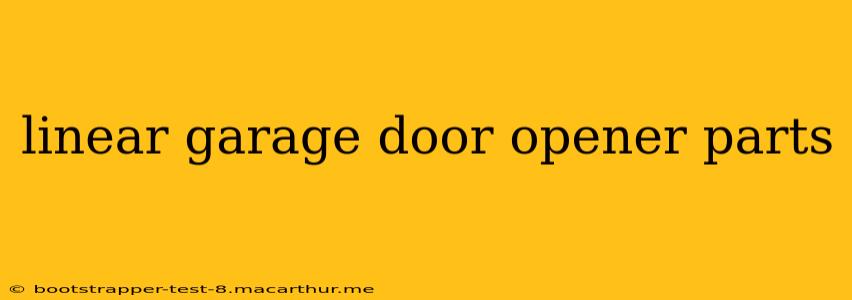Linear garage door openers are known for their reliability and smooth operation. However, like any mechanical device, they require occasional maintenance and, sometimes, repairs. Understanding the various parts of your Linear garage door opener is crucial for troubleshooting problems and performing necessary maintenance. This comprehensive guide will break down the key components, helping you navigate the world of Linear garage door opener parts with confidence.
What are the main parts of a Linear garage door opener?
A Linear garage door opener, while varying slightly depending on the model, generally comprises these core components:
-
Motor Unit: This is the powerhouse of the opener, responsible for driving the chain, belt, or screw drive that moves the garage door. It contains the motor itself, along with the control board and other electronics. Different Linear models use different motor types, impacting power and speed.
-
Drive System: This is the mechanism that translates the motor's rotational energy into linear motion to open and close your garage door. Linear offers several drive systems, including:
- Chain Drive: A classic, durable, and often more affordable option. These are generally louder than belt drives.
- Belt Drive: Quieter and smoother operation than chain drives, but often slightly more expensive.
- Screw Drive: Known for their strength and reliability, but can sometimes be less smooth than belt drives.
-
Remote Control Transmitters: These are the handheld devices used to operate your garage door opener from a distance. They send radio signals to the receiver in the motor unit. You'll often find multiple remotes included with a new opener.
-
Receiver: This component receives signals from the remote transmitters and initiates the opening or closing sequence.
-
Logic Board/Control Board: The brain of the operation, this board controls all the functions of the garage door opener, including safety features. Troubleshooting often involves examining this component.
-
Limit Switches: These switches tell the opener when to stop moving the door in either the open or closed position. Improperly adjusted limit switches can lead to the door not opening or closing fully.
-
Safety Sensors/Infrared Eyes: These are crucial safety features located near the bottom of the garage door tracks. They create an invisible beam; if something interrupts this beam, the door reverses to prevent accidents. Regular checks of these are vital.
-
Emergency Release Cord: A manual release mechanism allows you to disconnect the opener from the garage door, enabling you to open and close it manually in case of power outages or malfunctions.
-
Rail/Track System: The track system guides the carriage or trolley that moves along it, connecting the motor unit to the garage door. This often includes rollers and hangers.
-
Carriage/Trolley: This is the moving component that runs along the track, connected to the garage door. It translates the movement from the drive system to the door.
How do I identify the parts of my Linear garage door opener?
The best way to identify the specific parts is to consult your Linear garage door opener's manual. This manual will provide diagrams and descriptions of each component. If you've lost your manual, you can often find a digital copy on the Linear website, by searching for your model number.
What are common Linear garage door opener problems?
Many problems stem from relatively simple issues:
-
Remote not working: Check the batteries, ensure the receiver is functioning, and consider if the remote needs to be reprogrammed.
-
Door not closing completely: Adjust the limit switches.
-
Door opening or closing too slowly: This may indicate a problem with the motor, drive system, or worn-out rollers.
-
Safety sensors malfunctioning: Clean the lenses on the safety sensors or replace them if necessary.
How often should I perform maintenance on my Linear garage door opener?
Regular maintenance is key to prolonging the lifespan of your garage door opener. It’s recommended to lubricate the moving parts (chains, rollers, tracks) at least once or twice a year, and inspect the safety sensors regularly.
Where can I find replacement parts for my Linear garage door opener?
Replacement parts can be purchased from various online retailers or authorized Linear dealers. Always ensure you're ordering the correct parts for your specific model. You'll typically need your model number to correctly identify and order the appropriate components.
By understanding the individual parts and their functions, you can effectively troubleshoot minor problems, perform routine maintenance, and ensure your Linear garage door opener continues to operate smoothly and safely for years to come. Remember to prioritize safety and consult a professional if you're unsure about any repair or maintenance tasks.
